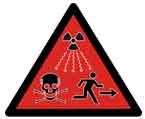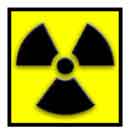
| INTRO |
| • The page is meant to be a quick guide for radiation exposure related to various medical procedures. As a basis for comparison of radiation exposure associated with medical procedures, the annual 3 mSv of naturally-occurring background radiation exposure is used as a baseline value. Another comparative table for all-source exposures uses the same 3 mSv of background radiation as starting point and the tsunami numbers of nuclear reactor meltdowns as high-end values of exposures. |
| • The source articles used for this info-page provide differing values in the millisieverts of exposure associated with some radiologic procedures. Some differences may be partly explained by duration of exposure and type of equipment in use. Also, the estimation of radiation dosage is an inexact science, and the numbers should be considered as best approximations. |
| BEIR (Biologic Effects of Ionizing Radiation) | ||||||||||||||||||
| • X-rays and gamma rays are sources of low linear energy transfer (low-LET) ionizing radiation. Humans are exposed to ionizing radiation from both natural and man-made sources. | ||||||||||||||||||
| • Most radiation sources are a mixture of high- and low LET radiation. Low-LET radiation deposits less energy in the cell along the radiation path and is considered less destructive per radiation track. BEIR defines low LET radiation as a dose between near zero to about 100 mSv (0.1 Sv). As points of comparison, annual background radiation in the U.S. is 3 mSv; a CXR exposure, about 0.1 mSv; and a whole body CT, about 10 mSv. | ||||||||||||||||||
• Worldwide background radiation of 2.4 mSv / year comes from:
|
||||||||||||||||||
• In the US population, 79% of man-made radiation exposure is from medical xrays and nuclear medicine; consumer products (tobacco, domestic water supply, building materials, and to a lesser extent, smoke detectors, TV, computer screens contribute about 16%; occupation exposures, fallout, and nuclear fuel cycle contribute about 5%. |
| X-rays are forms of radiant energy, like light or radio waves; but unlike light, they can penetrate the body to allow the visualization of internal structures through film or monitors: plain xrays, fluoroscopies, CT scans, mammography, etc. | |||
| Source | Effective Radiation Dose |
Compared to Natural Background Exposure of 3 mSv/year |
|
| Natural background exposure | 3 mSv / year | ||
| Airport Backscatter (Single scan) | 0.05 mSv | 30 mins | |
| Coast-to-coast round trip commercial flight |
about 0.03 mSV of cosmic rays |
18 mins | |
| Head and Neck | |||
| CT - Head | 2 mSv | 8 months | |
| CT - sinuses | 0.6 mSv | 2 months | |
| Dental radiography * | 0.07 mGy / 4 bitewings | 0.02 mGy / panoramic | 0.24 mGy / full-mouth exam |
| Chest / Heart / Lungs | |||
| CXR (chest x-ray, 2 views) | 0.1 mSv | 10 days | |
| CT - chest | 7 mSv | 2 years | |
| CT - chest / low-dose | 1.5 mSv | 10 days | |
| Cardiac CT / Calcium Scoring | 2 mSv | 2 months | |
| Coronary CT angiography | 8 - 20 mSv | 3 - 7 years | |
| Coronary angiography | 5 mSv | < 2 years | |
| Coronary MSCT | 10 mSv | > 3 years | |
| Resting scan plus Technetium-99 sestamibi cardiac stress scan |
11.3 msv | < 4 years | |
| Dipyridamole nuclear stress test (Thallium + technitium) | 25 msv | > 8 years | |
| Abdomen | |||
| Upper GI series | 5-6 mSv | 1.5 - 2 years | |
| Lower GI series (Barium Enema) | 7 - 8 mSv | 3 years | |
| Abdomen x-ray (AP) | 0.7 mSv | 3 months | |
| KUB x-ray (2 views) | 1.2 mSv | 4 months | |
| CT Abdomen | 8 mSv | 2 1/2 - 3 years | |
| CT Abdomen / Pelvis (combined) | 10 - 15 mSv | 3 - 5 years | |
| CT, Body | 2 - 10 mSv | ||
| CT / Colonography | 10 mSv | 3 years | |
| IVP (Intravenous pyelography) | 3 mSv | 1 year | |
| Ureteric stent insertion | 4.7 mSv | 20 months | |
| Voiding Cystourethrogram | 1.6 mSv (5-10 years old) 0.8 mSv (infant) |
6 months 3 months |
|
| Skeletal | |||
| Spine x-ray | 1.5 mSv | 6 months | |
| Extremity x-ray | 0.001 mSv | Less than 1 day | |
| CT - Spine | 6 mSv | 2 years | |
| Myelography | 4 mSv | 16 months | |
| DEXA (Bone densitometry) Male or Female |
0.001 mSv | Less than 1 day | |
| Women's Imaging | |||
| Galactography | 0.7 mSv | 3 months | |
| Hysterosalpingography | 1 mSv | 4 months | |
| Mammography | 0.4 - 0.5 mSv | 2 months | |
| Others | |||
| CT - Whole Body | 2 - 10 mSv | 6 months to 3 years | |
| Note: Some use 3.6 mSv as the amount of naturally-occurring background radiation exposure. | |||
| Note:The estimation of radiation dosage is an inexact science, so these numbers listed should be considered as best approximations. | |||
| Note: Radiation exposures vary depending upon the equipment and patient. | |||
| WHOLE-BODY BACKSCATTER SCANNERS |
Whole-body backscatter scanners are being deployed in airports across the United States. The scanner delivers narrow, low-density, high-speed xray beams over the entire person, front-and-back, to detect any hidden weapons or explosive devices. The dose from a backscatter scan may be as low as 0.05 uSv (equivalent to about 30 minutes of natural background radiation, or 4 to 5 minutes of air travel, or lee radiation exposure than one gets from eating a banana). Also, at a dose of 0.05 to 0.10 uSv, the 250 limit would be reach only if a person is scanned 2,500 to 5,000 times per year; highly improbable for any traveler. (Medscape) Millimeter Wave Machines: Another concern with backscatter scanners are privacy issues. The scanners provide very detailed body images, some calling them R-rated. Because backscanner machines could not meet the deadline on Congress mandated software to make the images more generic and less embarassing, backscatter scanners have beomce history in airports, to be replaced by millimeter wave machines by June 2013. Millimeter wave models use radio waves, so there is no ionizing radiation. (Sandra Fryhofer / Medicine Matters / September 2013 / Medscape) |
| RADIATION RISK FROM DENTAL RADIOGRAPHY |
| Radiation from dental radiography is so low it is highly unlikely to cause measurable risk. Brain exposure from 4 bitewings is about 0.07 mGuy, about 0.02 mGy for a panoramic exam, and 0.24 mGy for a full-mouth exam consisting of 12 periapical and 4 bitewing exposures. (A bitewing is a dental film for simultaneous xraying the crowns of the upper and lower teeth, help in place by a tab between the teeth.) In comparison, brain exposure from head CT is in the range of 43-75 mGy. A report concurs with the Claus study that suggests an association between dental radiography and meningiomas, but it is more likely the hemangiomas trigger the need for dental imaging than the other way around. (Medscape) |
| Sources and Suggested Readings |
| Are Full-Body Airport Scanners Safe? / Medscape |
Cancer Risk Overestimated With Radiation From CT Scans / Medscape Medical News |
| Patient Perceptions of Computed Tomographic Imaging and Their Understanding of Radiation Risk and Exposure / Ann of Em erg Me / Abstract |
| Radiation Exposure Tied to Lymphoma Risk in Men / Am J Epidemics 2009;169:969-976 / ACR |
| Radiation Dosage of EBT Procedures / prepared by Dr. Alan Boyer |
| Radiation Dose in Computed Tomography of the Heart: Morin RL, Gerber TC, MD & McCollough CH; Circulation 2003;107:917-922. |
| Reduced Radiation Exposure with the Use of an Air Retrograde Pyelogram During Fluoroscopic Access for Percutaneous Nephrolithotomy / Lipkin ME, Mancini JG, Ziberman DE et al / Journal of Endourology (Mar 2011) |
| Radiation Protection in Urology / |
| Radiation During Cardiovascular Imaging / Ariel Roguin and Prashant Nair / From British Journal of Cardiology / Medscape |
| Radiation Dose Associated With Common Computed Tomography Examinations and the Associated Lifetime Attributable Risk of Cancer / Rebecca Smith-Bindman, MD; Jafi Lipson, MD, Ralph Marcus, BA, Kwang-Pyo Kim, PhD et al / Arch Intern Med. 2009;169(22):2078-2086 |
| Radiation exposure: a quick guide to what each level means / DataBlog |
| Sievert / Wikipedia |
| CT Scans of the Heart Can Be Done with Low Radiation Dose /New Study Shows Wide Variation in Centers; Calls for Increased Education and Training to Achieve Optimum Results / Angioplasty.Org/Imaging News |
| Ultra-Low Radiation Dose Renal CT Examinations / Janet Cochrane Miller, D Phil., Author / Radiology Rounds, June 2011, Vol 9, Issue 6 |
| Long-Term Cancer Risks From Cardiac Imaging Radiation Remain Unknown / Marlene Busko / Medscape Internal Medicine News / |
| Beir VII: Health Risks from Exposure to Low Levels of Ionizing Radiation / Report in Brief / Expert Consensus Report |
| Multiple CT Scans Add Minimal Additional Cancer Risk / Daniel M. Keller, PhD / Medscape Internal Medicine News |
| What Are the Risks of Dental X-rays?: Radiation Risk From Dental Radiography / Sotirios Tetradis, DDS, PhD; Stuart C. White, DDS, PhD / Medscape Internal Medicine / Medscape Dentistry & Oral Health © 2012 |
| Initiative to Reduce Unnecessary Radiation Exposure from Medical Imaging / FDA • US Food and Drug Administration |
| Cancer Risks Associated With External Radiation From Diagnostic Imaging Procedures / Martha S. Linet, MD, MPH; Thomas L. Slovis, MD; Donald L. Miller, MD, FSIR; Ruth Kleinerman, MPH; Choonsik Lee, PhD; Preetha Rajaraman, PhD; Amy Berrington de Gonzalez, DPhil / CA CANCER J CLIN 2012;62:75–100 |




